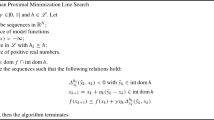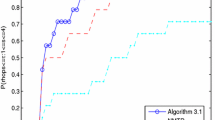Abstract
This paper considers the solution of the problem: inff[y, x(y)] s.t.y ∈\(\bar R\)[y, x(y)] ⊆E k, wherex(y) solves: minF(x, y) s.t.x ∈R(x, y) ⊆E n. In order to obtain local solutions, a first-order algorithm, which uses {dx(y)/dy} for solving a special case of the implicitly definedy-problem, is given. The derivative is obtained from {dx(y, r)/dy}, wherer is a penalty function parameter and {x(y, r)} are approximations to the solution of thex-problem given by a sequential minimization algorithm. Conditions are stated under whichx(y, r) and {dx(y, r)/dy} exist. The computation of {dx(y, r)/dy} requires the availability of ∇ y F(x, y) and the partial derivatives of the other functions defining the setR(x, y) with respect to the parametersy.
Similar content being viewed by others
References
R.L. Armacost and A.V. Fiaccco, Computational experience in sensitivity analysis for nonlinear programming, Math. Progr. 6(3).
R.L. Armacost and W.C. Mylander, A guide to a SUMT-version 4 computer subroutine for implementing sensitivity analysis in nonlinear programming. Technical Paper Serial T-287, The Institute for Managament Science and Engineering, The George Washington University, Washington, DC (1973).
D.P. Bertsekas, Nondifferentiable optimization via approximation, Math. Progr. Study 3(1975)1–25.
J.W. Blankenship and J.E. Falk, Infinitely constrained optimization problems, J. Optim. Theory Appl. 19, 2(1976).
J. Bracken and J. McGill, Mathematical programs with optimization problems in the constraints, Oper. Res. 21(1973)37–44.
J. Bracken and J. McGill, A method for solving mathematical programs with nonlinear programs in the constraints, Oper. Res. 22(1974)1097–1101.
A.H. deSilva, Sensitivity formulas for nonlinear factorable programming and their application to the solution of an implicitly defined optimization problem of US crude oil production, D.Sc. Dissertation, The George Washington University, Washington, DC (1978).
J.E. Falk, private communication.
A.V. Fiacco, Sensitivity analysis for nonlinear programming using penalty methods, Math. Progr. 10, 3(1976).
A.V. Fiacco and G.P. McCormick,Nonlinear Programming, Sequential Unconstrained Minimization Techniques (Wiley, 1968).
A. Ghaemi, A.H. deSilva and G.P. McCormick, Symbolic factorable SUMT: What is it? How is it used?, Technical Paper Serial T-402, The George Washington University, Washington, DC (May, 1979).
R.H.F. Jackson, Tensors, polyads, and high-order methods in factorable programming, D.Sc. Dissertation, The George Washington University, Washington, DC (1983).
C. Kolstad and L.S. Lasdon, Derivative evaluation and computational experience with large bilevel mathematical programs, BEBR Faculty Working Paper No. 1266, College of Commerce and Business Administration, University of Illinois ((July, 1986).
G.P. McCormick, Anti-zig-zagging by bending, Manag. Sci. 15(1969)315–320.
G.P. McCormick, A mini-manual for use of the SUMT computer program and the factorable programming language, Technical Report SOL 74-15, Systems Optimization Laboratory, Stanford University, Stanford, CA (August 1974).
R.L. Tobin and T.L. Friesz, Sensitivity analysis for equilibrium network flow, Transport. Sci. 22(1988)242–250.
Author information
Authors and Affiliations
Additional information
Research sponsored by National Science Foundation Grant ECS-8709795 and Office of Naval Research Contract N00014-89-J-1537. We thank the referees for constructive comments on an earlier version of this paper.
Rights and permissions
About this article
Cite this article
deSilva, A.H., McCormick, G.P. Implicitly defined optimization problems. Ann Oper Res 34, 107–124 (1992). https://doi.org/10.1007/BF02098175
Issue Date:
DOI: https://doi.org/10.1007/BF02098175




